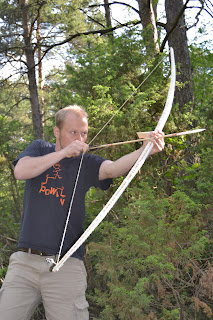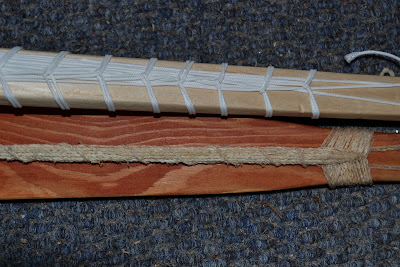 |
| 1. Denai´na bow in action. |
I recently tried out one of my birch Denai'na bows.The unbacked birch bow was 35pounds at a 25inch draw 158cm long. The bow had taken some set in earlier trials which gave it a 3 inch string follow. In retrospect this could have probably been avoided with a more prolonged heat-tempering of the belly. The birch had been too fresh to begin with and my initial heat-tempering was probably inefficient as moisture in the tree vaporized from the belly and acted as an cooling agent during the tempering process.
 |
| 2. The bow and arrow set before adding the cable. The arrow is a copy of a Denai'na arrow in the Furuhjelm collection. |
Most Denai´na bows in museum collections do not have any string follow so that means that I must be doing something wrong. Also the quality of the living birch tree might have a role in the performance of the bow.
 |
| 3. The Denaína bow Vk202 in the Museum of Culture in Helsinki. |
I have used Finnish birch (Petula pendula) for my bows. The Denai´na used, or prefered to use "Black Birch" which essentially is Alaskan birch (Betula neoalaskana). Possibly the Alaskan Birch has better bow qualities than the Finnish birch.Compression-failure is a real problem in these bows and heavy birch bows are more likely to fail in this way. This is one reason for the excessive wrapping on Dena'ina cable bows which cover most of the bow limbs.
 |
| 4. Real braided sinew and fake sinew. |
I added a artificial sinew cable to the bow to find out what effect it had. As I did not have any ready sinew cord I had to resort to an synthetic option. I chose to use 3mm braided blind nylon cord which I bought in a local fishing tackle store at 0.3€ per meter. I added two loops from nock to nock and proceeded to add more cable to the bow approx one handwith from the knocks, spacing ten hitches towards the center of the bow approx. one finger width apart. In total I had as many as 28 strands laying flat on the back in the center section of the bow. I then wrapped up the bow with what was left of the string. In all I used up 50 meters of nylon cord to back this one bow.
 |
| 5. Compare the two - the upper Denai'na bow has fake sinew, the lower Katmai bow has real sinew. |
This added 5 pounds to the draw but I also felt that the bow was "stacking" towards the end of the draw. Perhaps due to the fact that nylon does not have the same strechting qualities as sinew. Braided nylon does stretch a little but it is also has a more slippery feeling to it than real sinew. The latter grips the wood better than the nylon which tends to slip off more easily. To summerize I feelt that nylon should only be used as a temporary solution until real sinew line is produced.
 |
| 6.Athapascan draw, the arrow should be laying on the middle finger. |
Using the bow is an interesting experience as the peculiar Athabaskan archery technique. The arrow is drawn with the right hand but the arrow is placed on the right side of the bow and the arrow is laying on the bow between the left hand fingers of the archer between the index and middle finger or the middle finger and the ring finger. When drawing the bow the arrow is pulled towards the archers right eye and the bow is tilted to the left.The bow guard is above the thumb of the archer.
The arrow also reacts to this type of shooting technique by being prone to excessive "jumping", that is the arrow spine has to be flexible enough to enable this type of shooting technique. I have to explore this issue further before making more assumptions on this matter. My goal is to get the bows up to 50 - 55 pound draw weight which would be a realistic weight for larger game animals such as caribou.
Photo credits 1,2,4,5,6. Marcus Lepola. 3. Martti Kujansuu




